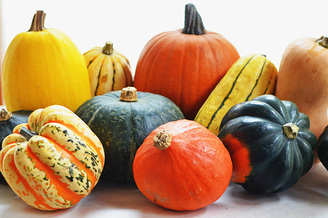In recent years, Autumn has changed from being a season of celebrating comfort food and cozy fires to instead one that focuses on pumpkin spice everything. I mean, take a look here at what is available out there; it's a bit ridiculous. But while pumpkin spice lattes, cookies, vacuum cleaners, etc. may have the spotlight and hearts of basic bitches everywhere, there is something that is being overlooked, and that is the actual pumpkin that the pumpkin spice was named for. Yes, my autumn loving friends, it isn't just the season of the PSL, but also pumpkin and winter gourd season. While many people may be surprised that there are uses for pumpkins and their related squash cousins beyond carving them for Halloween, it would be a crime to not reap their bounty and the multitude of preparations they can be used in.
So let's take a step back, don an apron over that Patagonia jacket, and put the Pumpkin back in Pumpkin Spice season.
You may be wondering what makes the winter squash, of which pumpkins are a part of, different from the summer squashes that you may be used to seeing these past months. The main characterizing differences lie in the thick, hearty outer rinds and the firm, drier flesh that inside. Winter Squash are harvested usually in late summer to autumn, and combined with their thick skins, they are able to be stored and stay edible for many months well into the winter.
- Butternut Squash
- Sugar Pumpkin (or Pie Pumpkin)
- Kabocha Squash
- Spaghetti Squash
- Acorn Squash
- Red Kuri Squash (or Hokkaido Pumpkin/Squash)
If you are at your local supermarket, these will often be grouped together and sold by the pound. When shopping for one of these, look for squashes and pumpkins that have firm, even skin and feel heavy for their size. After you get them home, you want to store them in a cool, dry place if possible. A pantry away from the stove and oven or a cool basement is perfect, while a fridge may be a bit too cold and harsh.
Something many of these winter squashes have in common (Spaghetti Squash being a main exception) is their firm, often orange flesh that softens and turns sweet and slightly nutty after being cooked.
When dealing with things like a butternut squash for the first time, it can be pretty tricky to work with. The first thing you will probably want to get rid of is the skin. If you are planning to roast your squash, the easiest way to get past the skin in my experience is to cut and prep the squash, cook it, and then remove the skin after cooking and briefly cooling. For smaller varieties like acorn squash, I like to split them in half lengthwise, scoop out the seeds, and roast them until tender and the flesh can be easily scooped out with a spoon. If you want to remove the skim before cooking like if you are making soup however, you do want to be careful and take a few precautions like shown in the video below.
Splitting a squash is probably the most difficult part and may require some elbow grease and muscle. First and foremost, you will want to use a large knife (a quality, heavy chef's knife is perfect here) and take extra care when cutting, keeping mind on keeping your fingers safe. The video below shows a great way to prep and peel a squash. If you do not feel comfortable using a knife to peel a squash, a vegetable peeler can also be used, but you may need to make a few passes in order to get through all the rind.
Winter Squash's firm texture and ability to develop deep, warm, sweetness when cooked make them great candidates for a variety of cooking methods, both wet and dry. Here are some good ones to try out.
Roasting: One of the most common and my personal favorite method is to roast slices or halved squashes and pumpkins. Simply preheat your oven to 400 degrees and coat your squash in vegetable or canola oil and sprinkle generously with salt and optionally, pepper. Roast until tender, checking occasionally until a knife can be inserted into the flesh easily.
Steaming: Another preparation that produces a milder flavour and softer texture than roasting is steaming. Simply cut your peeled or unpeeled pumpkin or squash into large pieces and steam in a steamer basket over medium-high heat until tender but not mushy.
Simmering: I usually use this method when I want to make a soup or bisque and don't have time to roast. I cut and peel my squash into large chunks along with any other vegetables and flavouring ingredients and simmer it all in water, broth, or stock over medium-low heat until tender. At this point, you can strain the squash and use it as you would like or you can puree the squash and cooking liquid in a blender until smooth. If you're feeling luxurious, you can finish the soup with some cream or half and half for extra richness. Voila, you just made a simple and quick soup!
Frying: I came across this method being used in Japanese cooking and it works quite well. Cut your squash into thin, medium sized slices and deep fry in oil around 375 degrees on medium heat until tender and lightly golden. Alternatively, you can also coat the squash slices lightly in corn starch or flour and deep fry for an even crispier exterior.
If you want to use pumpkin spice in making pumpkin pie, more power to you! The blend of warm spices that make your insides feel oh so cozy can also be used in more savoury preparations as well. Roasting pumpkin chunks seasoned with salt, pepper, paprika, and a little pumpkin spice mix can really bring out the warmth and nuttiness of the squash itself without turning it into dessert.
The same can be said when making a soup, where a little pumpkin spice when used in combination with a savoury base and other seasonings can bring depth and warmth to a dish. They key is not to use too much as to overpower the flavour of the squash itself and make everything just taste like under sweetened pumpkin pie filling. Moderation is key here.
Autumn's bounty means that just because the weather is getting colder, your food does not have to get more boring. Pumpkins and winter squash have a so much possibility stored within that it would be a shame to only use them to hold a candle on Halloween for a few hours. From their delicious, sweet and savoury flavours to their ability to be cooked in 101+ ways, these squash are deserving of your next food obsession.



